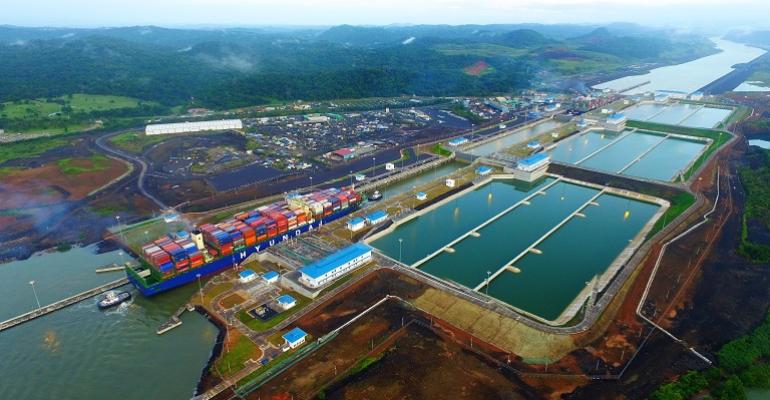On 30 October the Panama Canal Authority (ACP) shocked the industry when it announced it was reducing the number of booking slots and transits to 24, and then further to 22 effective December 1 to December 31, to 20 from January 1, 2024 to January 31 to 20, and as of February 1, 2024 to just 18 transits daily. The total transit numbers include both the Neo-Panamax and Panamax locks and are in response to Panama’s worst drought in 73 years which has led to a shortage of fresh water for the waterway.
In a letter addressed to Panama’s President Laurentino Cortizo, dated 30 October, Jeremy Nixon, CEO of ONE, argued that the water restrictions and operations had brought on-going delays and loading restrictions for large and bespoke Neo-Panamax containerships. “This has reached such a level of concern that strategically we start to consider alternatively routings of these fixed days schedule services from Asia via the Suez Canal. As our customers in both Asia and North America are complaining about the schedule reliability of our Panama transiting services for their on-time supply chain requirements.”
But Nixon went further to criticise the lack of concrete infrastructure projects to improve water reliability. “However, we also understand that no significant infrastructure projects have gone ahead in Panama to increase fresh water supply to the locks from other catchment areas,” Nixon said in his letter, hoping that “on behalf of our customers, that some urgent actions can now be taken by the Panama government towards the current uncertain situation.”
Nixon stated the ONE’s desire to “stay loyal” to the Panama Canal which had served the company and its shareholders – NYK, Mitsui OSK Lines, and K-Line – well for many years. ONE transits the canal along with its alliance partners Hapag-Lloyd, Yang Ming Line, and HMM.
Although the local press made a vague allusion to ONE’s communication, there have no public comments from either the Presidency or the ACP.
Listen to a recent episode of the Seatrade Maritime Podcast with Panama Canal Administrator Ricaurte Vasquez Morales
Meanwhile other owners have already started to divert sailings rather than face the uncertainty of long waits to transit the canal or paying millions of dollars for a slot at auction.
Bloomberg reported yesterday that two gas tankers crossed the Pacific, then U-turned within 10 miles of the Panama Canal because of the huge traffic jam caused by low water levels. The tankers, Pyxis Pioneer and the Sunny Bright, were within 10 miles of the canal before they changed course, according to ship-tracking data compiled by Bloomberg.
One tanker that U-turned was signaling a course towards Houston, the report said, suggesting it will bypass the traffic jam at the Panama Canal with a massive detour all the way around South America to get to the US Gulf Coast.
The other ship initially headed south as well, then turned west, and has indicated that it is still waiting for new orders, according to Bloomberg.
As of 8 November, the backlog was at 99 ships, up from 79 on 6 November, according to the ACP.
For owners looking to skip the queue by buying slots at auction costs are continuing to skyrocket. Japan’s Eneos Group made a winning bid $3.975 million for a transit at auction on Wednesday, in excess of a $1 million higher than the previous reported top bid of $2.85 million.
The huge cost of transits at auction is effectively pricing out some owners. In its weekly report Poten warned that large tanker owners would stop using the canal.
The Panama Canal is popular with shipowners and operators serving the trade between Asia and the US East Coast trade because offers short transit times than other options. The shipping time for ocean cargo from Shenzhen, China, to Miami, Florida, using the Suez Canal takes 41 days. Travelling through the Panama Canal takes only 35 days.
As the Canal’s drastic measures start to take effect on customers and daily transits, it has become urgent for the waterway to look for new and near sources of water.
In 2021, the Panama Canal Authority (ACP) signed a contract with the US Army Corps of Engineers (USACE) to evaluate potential alternatives and prepare conceptual designs amongst other tasks, said the ACP.
The USACE presented the ACP in 2023, with a preliminary report of possible solutions for the new water management system, estimated to cost around $2Bn, including the construction of a water reservoir. The ACP said having not defined all the projects.
The aspiration of the Panama Canal Authority is to have some of these projects operational by the end of 2026 to guarantee an additional supply of 1.4 billion cubic metres over the next few years. The ACP operations require some 3.4 billion cubic metres of water per year.
Copyright © 2024. All rights reserved. Seatrade, a trading name of Informa Markets (UK) Limited.
Add Seatrade Maritime News to your Google News feed.  |

